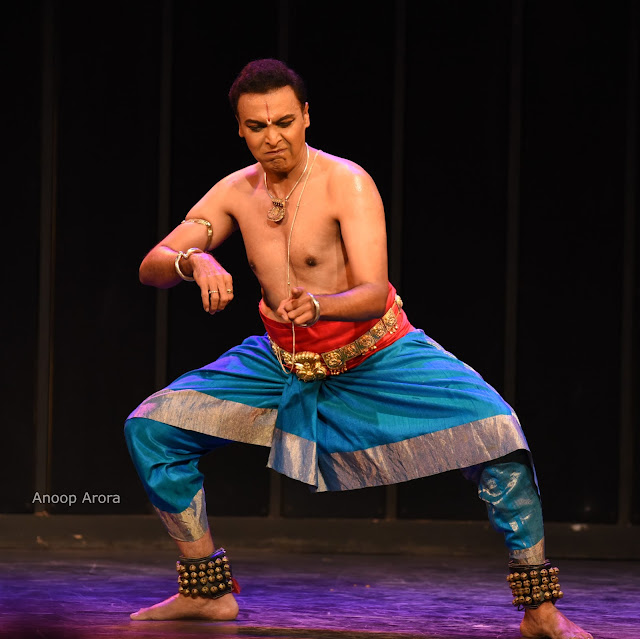Vaibhav Arekar: Training in abhinaya and theatre make my nritta expressive
 |
| (Here and below) Vaibhav Arekar at the Swathi Tirunal festival in Delhi |
Bharatanatyam exponent and teacher Vaibhav Arekar recently performed Anjaneya and other pieces in Delhi, and I was struck again by how expressive and deeply meaningful his work is. After the performance, I spoke to him about the pieces he performed and the extraordinarily expressive aspect of his style.

The natya element is very strong, even in your nritta. It’s not only the abhinaya which is talking, it’s also the nritta. So how do you explain your perspective? From what perspective do you conceptualize your pieces?
I think there are two things in my training which have had that effect. One is my abhinaya training with Dr. Kanak Rele. She comes from the Kerala tradition of abhinaya. We were established dancers already practising Bharatanatyam, but she wanted the abhinaya training to come from the Kerala tradition. So if you see the sancharis, they have an elaboration which is different, even in the way we enact them. I also trained in theatre with a friend when I did quite extensive dance theatre works. I did spoken theatre with dance, and we created a movement then. I see the drama in the dance. I like it. Even when it’s musical, I see the dance and I also like to see how the nritta emotes.

When I bring in Anjaneya, the sequence doesn’t matter. But if I’m Hanuman there, what is the energy of Hanuman? If I were doing a varnam with a viraha piece, where is the lyricism . . . I also worked with movements within the Bharatanatyam frame. I would love to explain nritta in its own sense, that it has a story of its own, when you speak in space. It’s abstract—why do we enjoy music? It’s something that hits, and similarly, movements also convey something. I think it comes from that.

How did you go about conceptualizing the energy and expressions in Anjaneya?
That was done by my guru, Dr. Kanak Rele. This was in 1993, when I had just passed out and she wanted to do a repertoire for me. And she said, “I don’t want you to do the nayikas, I’ll create something for you.” And she created this piece in place of a varnam. So the format is that it has jathis and swarams interspersed, but it’s not a varnam completely, so I don’t say it is. But that is how she introduced this. I’ve not changed anything, probably just an exploration of number of lines. But the entire flow is as she had taught me. As you grow up, the abhinaya sequences, the quick changes that she wanted of characters… all that in Anjaneya comes because I think I was slimmer then. She wanted to explore the space, so she took up Hanuman— she wanted me take this leap, go around, and this piece suited that. Her earlier student was Deepak Mazumdar, and his structure is completely different from my structure, so she worked with me according to my structure. And this is why Anjaneya is like that.

One of the best sequences is when he’s confused which shrub to pick from the mountain for Rama and Lakshmana – it was very interesting, with that touch of humour. How did you choreograph that dilemma?
That has grown a lot after the initial years. That was only a small piece, but as I grew as an artiste, I thought this particular portion is fun. The exploration of it came from something that happened, an incident when I had gone to pick up something in the market and I didn’t know what to do. I called my mom and said both are the same, so she’s like no, look at this and that (to differentiate). It was some vegetables I think. And that evening I was rehearsing Anjaneya for a performance and in that rehearsal that same thing came up, so the dilemma over the vegetables came into this particular piece.
When the people of Lanka are tying the cloth to Hanuman’s tail to set it afire, Hanuman casually picks up the tail and asks them to tie more cloth to it, so that he has a longer tail to burn down Lanka. That was another striking part of the piece.

The beauty of it is Dr. Rele said, “Now you to have to dance what I’m telling you,” and we were only 20 or 21, I think. But she said as you grow, you can expand it. You have the liberty to take it as you want. But it should come out of your own experience, not because you have to change something. So with experience the art changes. I have edited some pieces. Some pieces have become longer… like the depiction of the tail portion has become longer, but the earlier portion I have squeezed. Dr. Rele said, “Let it come out of experience.” I think I’ve only changed these pieces after my thirties – that is when we start exploring. The piece changed slightly, but not the flow. I haven’t taken new sancharis or edited things out.
Pics: Anoop Arora
This article first appeared on Narthaki.com


Comments
Post a Comment